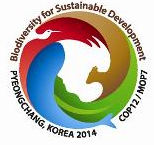Held from 6-17 October 2014, in Pyeongchang, the Republic of Korea, the twelfth meeting of the Conference of the Parties (COP 12) to the Convention on Biological Diversity (CBD) adopted a series of decisions, including the 'Pyeongchang roadmap for the enhanced implementation of the Strategic Plan and achievement of the Aichi Biodiversity Targets,' addressing resource mobilization, capacity building, scientific and technical cooperation, linking biodiversity and poverty eradication, and monitoring implementation of the Strategic Plan for Biodiversity 2011-2020.
 17 October 2014: Held from 6-17 October 2014, in Pyeongchang, the Republic of Korea, the twelfth meeting of the Conference of the Parties (COP 12) to the Convention on Biological Diversity (CBD) adopted a series of decisions, including the ‘Pyeongchang roadmap for the enhanced implementation of the Strategic Plan and achievement of the Aichi Biodiversity Targets,’ addressing resource mobilization, capacity building, scientific and technical cooperation, linking biodiversity and poverty eradication, and monitoring implementation of the Strategic Plan for Biodiversity 2011-2020.
17 October 2014: Held from 6-17 October 2014, in Pyeongchang, the Republic of Korea, the twelfth meeting of the Conference of the Parties (COP 12) to the Convention on Biological Diversity (CBD) adopted a series of decisions, including the ‘Pyeongchang roadmap for the enhanced implementation of the Strategic Plan and achievement of the Aichi Biodiversity Targets,’ addressing resource mobilization, capacity building, scientific and technical cooperation, linking biodiversity and poverty eradication, and monitoring implementation of the Strategic Plan for Biodiversity 2011-2020.
The results of COP 12 respond to the conclusions of the fourth edition of the Global Biodiversity Outlook (GBO 4), launched during the meeting, which indicate that, while progress is being made in conserving biodiversity, governments need to increase efforts if they are to end biodiversity loss. A key outcome of the meeting was also the reaffirmation of the COP 11 agreement to double total biodiversity-related international financial resource flows to developing countries by 2015 and at least maintain this level until 2020.
The meeting also adopted decisions on: health and biodiversity, seeking increased collaboration between the CBD and the World Health Organization; milestones for the elimination, phasing out or reform of incentives that are harmful to biodiversity, and the promotion of positive incentives; guidance on management of risks associated with the introduction of alien species as pets, aquarium and terrarium species, and as live bait and live food; and marine biodiversity, including on priority actions to achieve Aichi Target 10 for coral reefs, the review of regional workshops for describing ecologically or biologically significant marine areas (EBSAs), and key threats, including anthropogenic underwater noise and ocean acidification.
Furthermore, the meeting endorsed a plan of action on customary sustainable use of biodiversity; and decided to use the terminology “indigenous peoples and local communities” in future decisions and documents under the Convention. On synthetic biology, the meeting set out a comprehensive plan for further work under the Convention; and urged parties to have in place risk assessment procedures and regulatory systems with regard to the environmental release of organisms, components or products resulting from synthetic biology techniques, and to approve such organisms for field trials only after appropriate risk assessments have been carried out. The meeting also agreed on ways to integrate the work under the Convention and its Protocols, namely the Cartagena Protocol on Biosafety and the Nagoya Protocol on Access and Benefit-sharing (ABS), including holding concurrent meetings of the Convention and its protocols; and established a Subsidiary Body on Implementation, to replace the Ad Hoc Open-ended Working Group on Review of Implementation and to serve all instruments under the Convention.
The meeting’s High-Level Segment resulted in the adoption of the ‘Gangwon Ministerial Declaration on Biodiversity for Sustainable Development,’ which emphasizes the relevance and key contribution of the Strategic Plan for Biodiversity and its Aichi targets to the post-2015 development agenda, and invites the UN General Assembly to integrate it effectively; calls on governments, international organizations and stakeholders to link the implementation of the post-2015 development agenda to other relevant processes such as the UN Development Assistance Framework process and the national biodiversity strategies and action plans (NBSAPs); and recognizes the role of access and benefit-sharing (ABS) arising from the utilization of genetic resources in contributing to the conservation and sustainable use of biodiversity, poverty eradication and environmental sustainability.
CBD COP 13 will be held in 2016, in Mexico. [IISD RS coverage of CBD COP 12][CBD Press Release][Meeting Decisions][Gangwon Declaration]